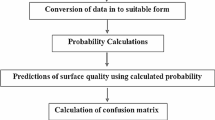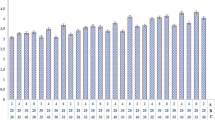Abstract
In order to effectively predict the surface roughness Ra of Ti-6Al-4 V material after magnetic abrasive finishing (MAF) process, and optimize the process parameters to improve the surface quality of the material. Firstly, diamond/Fe-based magnetic abrasive powders (MAPs) are prepared for the MAF process of Ti-6Al-4 V by using the gas–solid two-phase double-stage atomization and rapid solidification method. The effects of rotational speed of the magnetic pole, working gap, feed velocity of workpiece, and filling quantity of MAPs on the surface roughness efficiency are discussed. Secondly, the orthogonal experiment is designed. The prediction model of surface roughness based on gray wolf optimization (GWO) algorithm and support vector regression (SVR), which is constructed according to the experimental results. The simulation shows that the R2 of the optimized prediction model is 0.987456, and the MAPE is less than 1.99%. Finally, GWO algorithm is employed again to perform a global optimization search on the constructed prediction model. The optimal combination of process parameters is searched and verified, the surface roughness Ra is 0.098 μm, and the relative error is less than 2.82% compared with the model prediction. The comparison of surface morphology before and after MAF of Ti-6Al-4 V shows that the MAF technology combined with the prediction model based on GWO-SVR can effectively improve the surface quality of Ti-6Al-4 V.


















Similar content being viewed by others
Availability of data and material
The datasets used or analyzed during the current study are available from the corresponding author on reasonable request.
References
Yan Y, Chibowski E, Szcześ A (2017) Surface properties of Ti-6Al-4V alloy part I: surface roughness and apparent surface free energy. Mater Sci Eng C Mater Biol Appl 70(Pt 1):207–215. https://doi.org/10.1016/j.msec.2016.08.080
Pound BG (2014) Corrosion behavior of metallic materials in biomedical applications. I. Ti and its alloys. Corros Rev 32(1–2):1–20. https://doi.org/10.1515/corrrev-2014-0007
Sing SL, An J, Yeong WY, Wiria FE (2016) Laser and electron-beam powder-bed additive manufacturing of metallic implants: a review on processes, materials and designs. J Orthop Res 34(3):369–385. https://doi.org/10.1002/jor.23075
Kgoete FM, Popoola API, Fayomi OSI, Adebiyi ID (2018) Spark plasma sintered Ti-6Al-4V-Si3N4-TiN ternary composites: effect of combined microsized Si3N4 and TiN addition on microstructure and mechanical properties for aerospace application. J Alloy Compd 769:817–823. https://doi.org/10.1016/j.jallcom.2018.07.204
Sun CQ, Li YQ, Xu KL, Xu BT (2021) Effects of intermittent loading time and stress ratio on dwell fatigue behavior of ti-tanium alloy Ti-6Al-4V ELI used in deep-sea submersibles. J Mater Sci Technol 77:223–236. https://doi.org/10.1016/j.jmst.2020.10.063
Duraiselvam M, Valarmathi A, Shariff SM, Padmanabham G (2014) Laser surface nitrided Ti-6Al-4V for light weight automobile disk brake rotor application. Wear 309(1–2):269–274. https://doi.org/10.1016/j.wear.2013.11.025
Niinomi M (1998) Mechanical properties of biomedical titanium alloys. Mater Sci Eng A 243(1–2):231–236. https://doi.org/10.1016/S0921-5093(97)00806-X
Ma L, Wang X, Zhou Y et al (2021) Biomimetic Ti-6Al-4V alloy/gelatin methacrylate hybrid scaffold with enhanced osteogenic and angiogenic capabilities for large bone defect restoration. Bioact Mater 6(10):3437–3448. https://doi.org/10.1016/J.BIOACTMAT.2021.03.010
Zhang ZY, Shi ZF, Du YF, Yu ZJ, Guo LC, Guo DM (2018) A novel approach of chemical mechanical polishing for a tita-nium alloy using an environment-friendly slurry. Appl Surf Sci 427:409–415. https://doi.org/10.1016/j.apsusc.2017.08.064
Cheng YH, Wang LS, Yu SW, Min R (2021) Studies on the electro-mechanical polishing effects of titanium alloy with ion-exchange resin solid particles. J Alloy Compd 854:157269. https://doi.org/10.1016/j.jallcom.2020.157269
Nesli S, Yilmaz O (2021) Surface characteristics of laser polished Ti-6Al-4V parts produced by electron beam melting additive manufacturing process. Int J Adv Manuf Technol 114(1–2):271–289. https://doi.org/10.1007/s00170-021-06861-6
Wang B, Zhang ZY, Chang KK, Cui JF, Rosenkranz A, Yu JH, Lin CT, Chen GX, Zang KT, Luo J, Jiang N, Guo DM (2018) New deformation-induced nanostructure in silicon. Nano Lett 18(7):4611–4617. https://doi.org/10.1021/acs.nanolett.8b01910
Zhang ZY, Cui JF, Wang B, Wang ZG, Kang RK, Guo DM (2017) A novel approach of mechanical chemical grinding. J Alloy Compd 726:514–524. https://doi.org/10.1016/j.jallcom.2017.08.024
Zhang ZY, Huang SL, Wang SC, Wang B, Bai Q, Zhang B, Kang R, Guo D (2017) A novel approach of high-performance grinding using developed diamond wheels. Int J Adv Manuf Technol 91(9–12):3315–3326. https://doi.org/10.1007/s00170-017-0037-3
Abushanab WS, Moustafa EB, Harish M, Shanmugan S, Elsheikh AH (2022) Experimental investigation on surface characteristics of Ti6Al4V alloy during abrasive water jet machining process. Alex Eng J 61(10):7529–7539. https://doi.org/10.1016/j.aej.2022.01.004
Chang GW, Yan BH, Hsu RT (2002) Study on cylindrical magnetic abrasive finishing using unbonded magnetic abrasives. Int J Mach Tools Manuf 42(5):575–583. https://doi.org/10.1016/S0890-6955(01)00153-5
Wang Y, Hu D (2005) Study on the inner surface finishing of tubing by magnetic abrasive finishing. Int J Mach Tools Manuf 45(1):43–49
Qian C, Fan ZH, Tian YB, Liu YH, Han JG, Wang JH (2021) A review on magnetic abrasive finishing. Int J Adv Manuf Technol 112:619–634. https://doi.org/10.1007/s00170-020-06363-x
Lu XH, Xue L, Ruan FX, Yang K, Liang SY (2019) Prediction model of the surface roughness of micro-milling single crystal copper. J Mech Sci Technol 33(11):5369–5374. https://doi.org/10.1007/s12206-019-1030-6
Lipiński D, Bałasz B, Rypina Ł (2018) Modelling of surface roughness and grinding forces using artificial neural networks with assessment of the ability to data generalisation. Int J Adv Manuf Technol 94(1–4):1335–1347.https://doi.org/10.1007/s00170-017-0949-y
Aich U, Banerjee S (2014) Modeling of EDM responses by support vector machine regression with parameters selected by particle swarm optimization. Appl Math Model 38(11–12):2800–2818. https://doi.org/10.1016/j.apm.2013.10.073
Shinmura T, Takazawa K, Hatano E, Matsunaga M, Matsuo T (1990) Study on magnetic abrasive finishing. CI-RP Ann Manuf Technol 39:325–328
Gao YW, Zhao YG, Zhang GY, Yin FS, Zhang HY (2020) Modeling of material removal in magnetic abrasive finishing p-rocess with spherical magnetic abrasive powder. Int J Mech Sci 177:105601. https://doi.org/10.1016/j.ijmecsci.2020.105601
Hanada K, Yamaguchi H, Zhou H (2008) New spherical magnetic abrasives with carried diamond particles for internal finishing of capillary tubes. Diam Relat Mater 17:1434–1437. https://doi.org/10.1016/j.diamond.2008.01.100
Tan XX, Wang SY, Chen Y, Zhou YW, Li Z (2019) Design, preparation and characterization of iron nitride magnetic abrasives. J Alloy Compd 774:443–450. https://doi.org/10.1016/j.jallcom.2018.09.389
Gao YW, Zhao YG, Zhang GX (2018) Preparation of Al2O3 magnetic abrasives by gas-solid two-phase double-stage atomization and rapid solidification. Mater Lett 215:300–304. https://doi.org/10.1016/j.matlet.2017.12.124
Gao YW, Zhao YG, Zhang GX, Yin FS, Zhao GY, Guo H (2020) Preparation and characterization of spherical diamond magnetic abrasive powder by atomization process. Diam Relat Mater 102:107658. https://doi.org/10.1016/j.diamon-d.2019.107658
Vladimir V, Esther L, Yann LC (1994) Measuring the VC-dimension of a learning machine 6(5):851–876. https://doi.org/10.1162/neco.1994.6.5.851
Kamboj VK, Bath SK, Dhillon JS (2015) Solution of non-convex economic load dispatch problem using grey wolf optimizer. Neural Comput Appl 27(5):1301–1316. https://doi.org/10.1007/s00521-015-1934-8
Mirjalili S, Mirjalili SM, Lewis A (2014) Grey wolf optimizer Adv Eng Softw 69:46–61. https://doi.org/10.1016/j.advengsoft.2013.12.007
Heidari AA, Pahlavani P (2017) An efficient modified grey wolf optimizer with Lévy flight for optimization tasks. Appl Soft Comput 60:115–134. https://doi.org/10.1016/j.asoc.2017.06.044
Funding
The authors would like to acknowledge all the support received from the National Natural Science Foundation of China (No. 51875328) and the Natural Science Foundation of Shandong Province (No. ZR2019MEE013).
Author information
Authors and Affiliations
Contributions
The method was conceived by Yugang Zhao, the experiments were designed by Zhuang Song and performed by Guangxin Liu, Yuewu Gao, Xiajunyu Zhang, Chen Cao, Di Dai, and Yueming Deng. All the authors took part in the paper.
Corresponding author
Ethics declarations
Ethics approval
Not applicable.
Consent to participate
Not applicable.
Consent for publication
Not applicable.
Conflict of interest
The authors declare no competing interests.
Additional information
Publisher's note
Springer Nature remains neutral with regard to jurisdictional claims in published maps and institutional affiliations.
This article is part of the Topical Collection: New Intelligent Manufacturing Technologies through the Integration of Industry 4.0 and Advanced Manufacturing
Rights and permissions
About this article
Cite this article
Song, Z., Zhao, Y., Liu, G. et al. Surface roughness prediction and process parameter optimization of Ti-6Al-4 V by magnetic abrasive finishing. Int J Adv Manuf Technol 122, 219–233 (2022). https://doi.org/10.1007/s00170-022-09354-2
Received:
Accepted:
Published:
Issue Date:
DOI: https://doi.org/10.1007/s00170-022-09354-2




